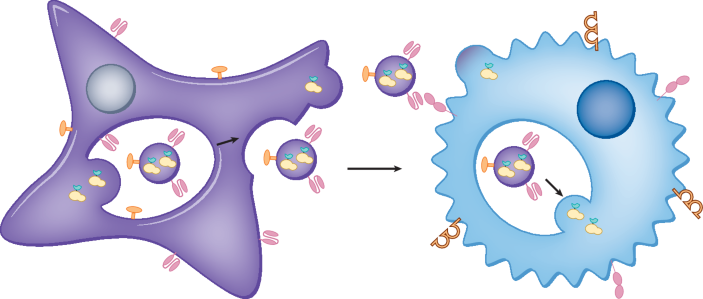The widening range of strategies to alter the phenotypes and functions of mammalian cells is a boon for their biomedical applications.
‘How to engineer a cell’ could be the title of a thick book that gets substantially heavier with every new edition. Indeed, there is an increasing number of methods to modify mammalian cells to, for instance, express specific receptors, produce certain cytokines, metabolites or hormones, or excrete extracellular vesicles with biased tropism or functionality. When differentiating stem cells, their transformation path can be biased towards certain lineages with increasingly easier or more efficient protocols. And some somatic cell types can be reprogrammed into a more stem-cell-like state, or transdifferentiated into another cell type. In general, many cellular functions can be switched off or potentiated, and new functions introduced. Nearly everything in a cell can be tinkered with — from the genes to the glycocalyx on the cell’s surface (and including the structural organization of the genome, gene-expression profiles, the shuttling of transcription factors through the nucleus, protein production, signalling networks, protein distribution, cytoskeletal organization, organelle functions, and the expression and display of specific cell-surface receptors; this is not an exhaustive list). The biochemical and biophysical microenvironment of cells can also be controlled as a way to alter cellular phenotypes.

Yet, cell engineering is more than just tinkering with cells; the concept suggests a degree of control for a biological or biomedical purpose. In genome engineering, genes are introduced, knocked out or silenced, or their promoter regions modified, to make cells express specific receptors or produce certain cytokines, for instance. All of these modifications can be done via genome editing (through CRISPR-associated nucleases), transposon systems (such as Sleeping Beauty or piggyBac) or the viral transduction or non-viral transfection of nucleic acid payloads (for example, in optogenetics, these can be light-responsive gene-expression systems). In epigenetic engineering, the epigenetic landscape of cells and thus gene-expression patterns and cellular behaviour can be altered via RNA interference, DNA-methylation editing, or histone or chromatin remodelling. In metabolic engineering, enzymes involved in biosynthetic pathways can be overexpressed or knocked down, or precursors or co-factors can be added, to enhance the production of desired molecules. With synthetic biology, genetic circuits can be reprogrammed (via logic gates or feedback loops, for example) to use cells as sensors or reporters of specific biochemical or physical cues in their microenvironment. With protein engineering, the extracellular domain of receptors can be optimized to enhance their binding affinity or specificity. The composition and targeting specificity of secreted extracellular vesicles can also be engineered (genetically, and via microenvironmental stimuli) for uses in the delivery of biomolecules and in diagnostics. In cell-surface engineering, ligands (typically antibodies) are used to alter cell–cell communication and the interactions of the cells with the extracellular matrix. And bioprinting and culture techniques (culture conditions such as oxygen levels, pH, nutrient availability and shear stress can influence the expression of particular receptors and the secretion of certain cytokines and extracellular vesicles) alongside genetic and epigenetic manipulations can be used to induce specific cell states (such as senescence or pluripotency), and to construct multicellular tissue models to recapitulate the structural and functional aspects of native tissues, or for use in tissue regeneration.
The requirements of the application, the cell type, the cell components to be altered, and the desired levels of control and scalability typically dictate the types of strategy for cell engineering. For example, as shown by Joshua Leonard and colleagues in an Article included in this issue of Nature Biomedical Engineering, to effectively deliver biologics to T cells via extracellular vesicles, the vesicles’ parent cells were genetically modified to secrete vesicles displaying single-chain variable fragments binding to a specific receptor on T cells as well as viral glycoproteins to facilitate vesicle uptake and fusion with the recipient T cells (pictured). The parent cells were also encoded genetically to load specific cargo into the vesicles during their biogenesis (by tagging the cargo with vesicle-localizing domains). And for the delivery of mRNA into neurons, leucocytes can be engineered to produce extracellular vesicles that incorporate retrovirus-like mRNA-packaging capsids (to enhance the loading of the RNA cargo, to recruit enveloping proteins to their surface and to promote uptake by recipient neurons), as described by Shaoyi Jiang, Robert Langer and colleagues in another Article in this issue.
To lower the immunogenicity of transplanted allogeneic cells and tissues, immunomodulatory transgenes can be overexpressed (by inserting the transgenes with expression vectors for piggyBac and Sleeping Beauty transposons), as described by Andras Nagy in this issue, for the ‘cloaking’ of embryonic stem cells and tissues derived from them. And to enhance the antigen-specific immunosuppression of allogeneic mesenchymal stromal cells, which are used to treat immune disorders, Saad Kenderian and co-authors show that the cells can be genetically modified to incorporate chimaeric antigen receptors for the cell-adhesion protein epithelial cadherin, for the treatment of graft-versus-host disease in mice. Moreover, to enhance the antitumour activity of T cells with chimaeric antigen receptors targeting solid tumour antigens, Stephen Gottschalk and colleagues designed a system based on the ‘leucine zipper’ structural motif to replace (via retroviral transduction) the extracellular domains of heterodimeric cytokine receptors in T cells with two leucine zippers (which provided optimal Janus kinase (JAK)/signal transducer and activator of transcription (STAT) signalling).
Advances in genome engineering, viral and non-viral delivery, high-content screening, computational modelling (for protein design, the processing of omics datasets, and the optimization of nucleic acid sequences, among a plethora of other uses) and in many disparate methods of molecular and cellular biology are widening the range of strategies for cell engineering. Whether the aim is to design or optimize cells as therapeutics or biosensors, or for use in disease modelling or for evaluating the toxicities of biologics, the strategies in the methodological toolbox are myriad.
Rights and permissions
About this article
Cite this article
The myriad ways to engineer cells. Nat. Biomed. Eng (2024). https://doi.org/10.1038/s41551-024-01213-7
Published:
DOI: https://doi.org/10.1038/s41551-024-01213-7
